Yesterday night Umbra students didn’t eat their curds and whey, they separated them. In another of a series of food-making workshops, Umbra staff member Zach Nowak lead a cheesemaking class in the kitchen-classroom of the Institute’s Via Marzia building. Students first learned the theory of cheese (how early pastoralists needed to be able to store their milk, the role of bacteria in cheesemaking, how rennet works), and then used rennet to separate, quite literally, the curds from the watery whey. Nowak, an amateur cheesehead, also showed the class some of his own fresh cheese, which they spread on bread before concluding the class. Yum! (photo by Frank Seijas)
Month: February 2007
Students in Professor Peter Fischer’s History and Culture of Food class participated in their field trip on Friday to Fattoria San Corzano and Montespertoli in Tuscany. At Fattoria San Corzano students were guided through the wine-making process and then enjoyed a wine and cheese
tasting. Fattoria San Corzano produces wine, cheese from sheep’s milk and olive oil. Students then headed to Montespertoli and learned how to cook a typical Tuscan meal from Jacopo Tendi. Students learned some tricks of the trade in the Italian kitchen and also made most of the dishes themselves. They then sat down to enjoy a Tuscan feast which consisted of:
Ravioli fatta in casa ripieno di spinaci e ricotto con burro e salvia
Gnocchi fatta in casa con pomodoro
Pollo ai cacciatore
Patate al forno
Melanzane parmigiana
Tiramisu
 Last night, in another installment of the Safari series, Umbra students went after the slowest-moving prey in the Italian trophy field: a great pizza. Perugia, like every Italian city, is filled with great pizzerias, but sometimes the best are the ones you just might not notice. Umbra staff member and student guidebook coordinator Zach Nowak lead a group of Umbra students through Perugia’s back alleys to several little-known pizzerias, finally stopping at a no-name hole-in-the-wall in the Via della Viola neighborhood where the pizzaiolo (pizza maker) is called Felice (“Happy”) and the pizza is delicious. Over their slices the students discussed different toppings, why pizza is associated with Naples, and the extra-price-for-extra-goodness Italian favorite, mozzarella di bufala. A good time – and what’s better, a good pizza – was had by all.
Last night, in another installment of the Safari series, Umbra students went after the slowest-moving prey in the Italian trophy field: a great pizza. Perugia, like every Italian city, is filled with great pizzerias, but sometimes the best are the ones you just might not notice. Umbra staff member and student guidebook coordinator Zach Nowak lead a group of Umbra students through Perugia’s back alleys to several little-known pizzerias, finally stopping at a no-name hole-in-the-wall in the Via della Viola neighborhood where the pizzaiolo (pizza maker) is called Felice (“Happy”) and the pizza is delicious. Over their slices the students discussed different toppings, why pizza is associated with Naples, and the extra-price-for-extra-goodness Italian favorite, mozzarella di bufala. A good time – and what’s better, a good pizza – was had by all.
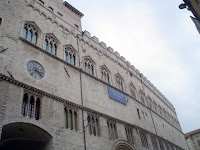 All-year student, Paul Schiller, has the exciting opportunity to work for the city of Perugia as part of his honor’s course, Perugia Practicum. Schiller is helping with translations for the city’s newspaper and website, tackling translations of such words as aggiudicataria (highest bidder), cianografia (blueprint), and fascicolato (bound). After his first hectic day at the office, Schiller commented that after “two and a half hours and four espressos, I had the pleasure of seeing what it’s like to work in the Italian office.”
All-year student, Paul Schiller, has the exciting opportunity to work for the city of Perugia as part of his honor’s course, Perugia Practicum. Schiller is helping with translations for the city’s newspaper and website, tackling translations of such words as aggiudicataria (highest bidder), cianografia (blueprint), and fascicolato (bound). After his first hectic day at the office, Schiller commented that after “two and a half hours and four espressos, I had the pleasure of seeing what it’s like to work in the Italian office.”
For three students, this weekend’s optional trip to Civita’ di Bagnoregio, Viterbo, Orvieto and Todi was especially meaningful. Three students from the Franciscan Heritage Program at Umbra along with Professor Micheal Chiariello and his wife, Judy, from St. Bonaventure University in New York
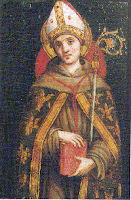 state were among the group of Umbra students who embarked on this two-day excursion. Our first stop at Civita’ di Bagnoregio is the birthplace of St. Bonaventure after whom the university was named. “To be able to visit the birthplace of St. Bonaventure, while studying his philosophy, is only possible with this unique program,” said Professor Chiariello. St. Bonaventure of Bagnoregio, born Giovanni di Fidanza in 1221, was cured of a childhood illness by St. Francis of Assisi became a Franciscan friar and a Cardinal. St. Bonaventure is said to be one of the most prominent men in Latin Christianity.
state were among the group of Umbra students who embarked on this two-day excursion. Our first stop at Civita’ di Bagnoregio is the birthplace of St. Bonaventure after whom the university was named. “To be able to visit the birthplace of St. Bonaventure, while studying his philosophy, is only possible with this unique program,” said Professor Chiariello. St. Bonaventure of Bagnoregio, born Giovanni di Fidanza in 1221, was cured of a childhood illness by St. Francis of Assisi became a Franciscan friar and a Cardinal. St. Bonaventure is said to be one of the most prominent men in Latin Christianity.
 Coffee, caffè, Koffee, café: a cup of Joe by any other name would…still be black and inky but oh so irresistible! Last night was another edition of the Umbra Institute’s semi-regular Coffee Safaris. Six students, with staff member Zachary Nowak as their guide, braved the inclement weather for a round of the Perugia’s possibilities for an espresso, cappuccino, or whatever suits you. Stops included Sandri (the most chic), Caffè di Roma (which Perugians call “lo Starbucks” for its American-style layout), and Caffè Morlacchi, haunt of many a student and professor from the nearby Faculty of Humanities. The Safari series will continue next week with pizza!
Coffee, caffè, Koffee, café: a cup of Joe by any other name would…still be black and inky but oh so irresistible! Last night was another edition of the Umbra Institute’s semi-regular Coffee Safaris. Six students, with staff member Zachary Nowak as their guide, braved the inclement weather for a round of the Perugia’s possibilities for an espresso, cappuccino, or whatever suits you. Stops included Sandri (the most chic), Caffè di Roma (which Perugians call “lo Starbucks” for its American-style layout), and Caffè Morlacchi, haunt of many a student and professor from the nearby Faculty of Humanities. The Safari series will continue next week with pizza!
Valentine’s Day is a little more special in Umbria than in other Italian regions as the third-century bishop was from the nearby city of Terni. Saint Valentine supposedly married a Christian woman and a pagan man and got the normal Roman thanks for his act: his head was lopped off, followed by sainthood.
The Umbra Institute decided that for yesterday’s Tandem language exchange meeting, the saint’s memory would be honored in a particularly appropriate way: lots of Nutella. Italians turn up their noses at American desserts – brownies, fudge, andcaramel-covered apples – but drown their sorrows and celebrate their victories in jars full of the hazelnut-chocolate spread. It’s the strange student apartment that doesn’t have a collection of empty jars with “nutella” written on the side.
In any event, the Tandem meeting, with its near-record crowd, was a huge success, commented Umbra staff member and Tandem coordinator Mauro Renna. Chocolate seemed to inspire particularly fruitful exchanges about desserts and junk food, among others. Hats off to Saint Valentine!
 Monday was just like any other day for Umbra students—a shot of caffè and a cornetto, Italian class, a slice of pizza or a Parma panino, and probably a few more classes. But it didn’t take too much thought first thing in the morning to figure out something was different. As the students made their early-morning trek through Piazza IV Novembre, it became clear that the 29th of January is no ordinary day in Perugia. The streets were noticeably crowded—all the Perugians had the day off. This day marks the Festa di San Costanzo, Perugia’s patron saint day. San Costanzo was Perugia’s first bishop, and was beheaded and martyred in the year 170 AD.
Monday was just like any other day for Umbra students—a shot of caffè and a cornetto, Italian class, a slice of pizza or a Parma panino, and probably a few more classes. But it didn’t take too much thought first thing in the morning to figure out something was different. As the students made their early-morning trek through Piazza IV Novembre, it became clear that the 29th of January is no ordinary day in Perugia. The streets were noticeably crowded—all the Perugians had the day off. This day marks the Festa di San Costanzo, Perugia’s patron saint day. San Costanzo was Perugia’s first bishop, and was beheaded and martyred in the year 170 AD.
On Corso Vanucci, a tent was set up with tables filled with torcolo: a traditional pastry made in Perugia during the months of January and February. The ring-shaped fruit cake symbolizes the union of lovers, of which San Constanzo is the protector. Single Perugian women take place in the traditional baking contest of torcolo and head down Corso Cavour to the Chiesa San Costanzo. They offer the cake to the statue of San Costanzo in hopes of being married. It is said that if the statue winks, wedding bells will ring within the year.
The day is also celebrated with an open-air market on Corso Cavour, lined with street vendors selling everything from pots and pans to Perugina chocolate to Italian leather boots. Many Umbra students were fortunate enough to find a break in the day to push their way through the crowds on Corso Cavour, poke around the market, and even see the San Costanzo statue (otherwise closed to the public the rest of the year).
For those ladies who aren’t the best bakers, pick up a Perugina Baci or two on the way to the chiesa—you may still get a wink from San Costanzo.
(text by Natalie Stephens, Frank Seijas, and Lindsey Stenberg)
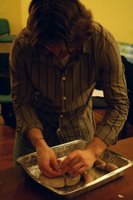 “Laws are like sausages: those who like them should not see them being made.” So opined the nineteenth-century Prussian chancellor Otto von Bismarck. Despite this warning, an overbooked class of Umbra students handmade sausages last night. The class began with an introduction to sausages by Umbra staff member Zach Nowak. Nowak, who makes his own sausages and even prosciutto at h
“Laws are like sausages: those who like them should not see them being made.” So opined the nineteenth-century Prussian chancellor Otto von Bismarck. Despite this warning, an overbooked class of Umbra students handmade sausages last night. The class began with an introduction to sausages by Umbra staff member Zach Nowak. Nowak, who makes his own sausages and even prosciutto at h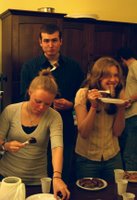 ome, gave the students some historical background on sausages and their preservation before discussing some of the cultural differences between sausage ingredients in different countries.
ome, gave the students some historical background on sausages and their preservation before discussing some of the cultural differences between sausage ingredients in different countries.
The didactic part done, staff members Mauro Renna and Nowak directed as the students ground the meat, mixed in spices (including fresh orange zest), and filled the casings. The best part, of course, was the eating. Accompanied by sautéed sauerkraut, bell peppers, and onions, the students wolfed down a number of sausages each – judging by the empty plates and smiles, the workshop was a success!
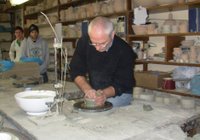 The U. Grazia ceramics store is the 13th oldest company in the world. Some of their pottery dates back to the 1400s, which explains the success of the majolica today—they’ve had many years to perfect their craft. On a recent class visit to Deruta, the center of Italian ceramics, Umbra students took a tour of the factory guided by a potter who works there. The tour included all aspects of the pottery process from clay to bisque to fired pottery. It even included watching skilled artisans, born and trained in Deruta, paint traditional grotesque patterns on to the unfired bisque.
The U. Grazia ceramics store is the 13th oldest company in the world. Some of their pottery dates back to the 1400s, which explains the success of the majolica today—they’ve had many years to perfect their craft. On a recent class visit to Deruta, the center of Italian ceramics, Umbra students took a tour of the factory guided by a potter who works there. The tour included all aspects of the pottery process from clay to bisque to fired pottery. It even included watching skilled artisans, born and trained in Deruta, paint traditional grotesque patterns on to the unfired bisque.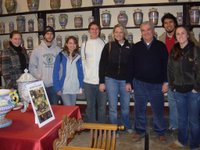
The most interesting part of the Grazia company is Signore Grazia himself. A cultured and outgoing man, he treated the students as warmly as he would have treated any of his other celebrity customers. Evidence of his prestigious clientele is found in Signore Grazia’s impressive guestbook that dates back to 1926 and hold the signatures of high society such as the Beatles and Paul Simon, and several notable politicians.
A visit to the showroom allowed students to view some of the modern pottery designs. Unfortunately, it is difficult to drop 35 euro on a teacup when on a college student’s budget. Nevertheless, the students enjoyed the tour and especially the opportunity to meet such a pleasant character as Signore Grazia.

